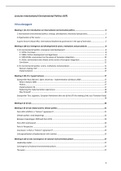Class notes
College aantekeningen MAN-MMW015 International Environmental Politcs
- Course
- Institution
- Book
In these lecture notes, it is important to know that NOT all guest lectures are covered, as these are NOT exam material. All the regular lectures are covered. It is a summary of the slides together with notes from the lectures told by the lecturer: prof. ir. Duncan Liefferink.
[Show more]



